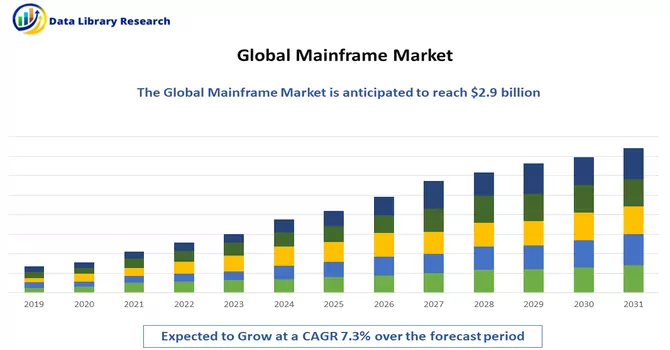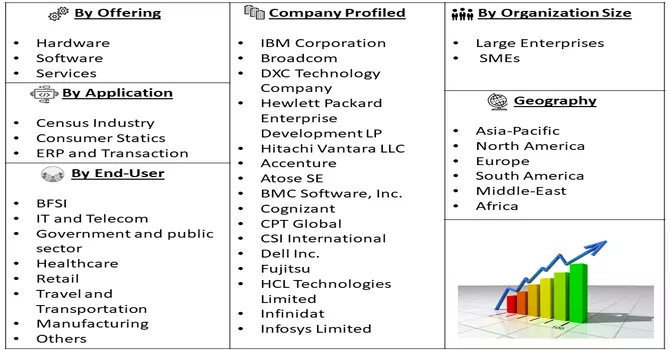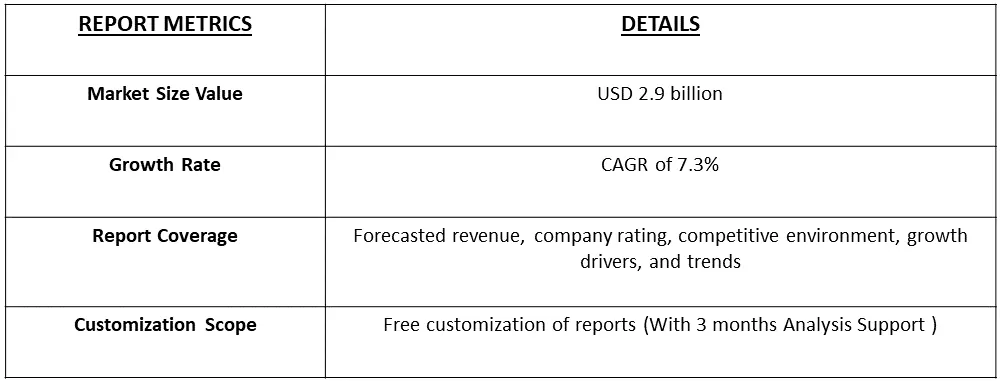The global mainframe market was valued at $2.9 billion in 2022 and is projected to reach $5.6 billion by 2032, growing at a CAGR of 7.3% from 2023 to 2032.

Get Complete Analysis Of The Report - Download Free Sample PDF
A mainframe is a powerful and large-scale computer system that is designed for handling and processing a high volume of data and transactions. It serves as the backbone of many large organizations and is characterized by its reliability, stability, and ability to manage extensive workloads. Mainframes are known for their robustness and are often used for critical applications that require high levels of availability and security. Mainframes are equipped with significant processing power to handle complex calculations and data processing tasks. They are designed to efficiently execute large volumes of transactions simultaneously.
The global mainframe market is driven by several key factors that contribute to its sustained growth. One of the primary driving forces is the unparalleled processing power and scalability offered by mainframes, making them indispensable for organizations handling vast amounts of data and complex transactions. The continued reliance on legacy systems, especially in industries such as finance, healthcare, and government, further fuels the demand for mainframes, as these systems provide robustness, reliability, and security. Additionally, the rise of big data analytics and the need for efficient processing of large datasets contribute to the market's expansion. Mainframes also play a crucial role in supporting digital transformation initiatives by seamlessly integrating with modern technologies. As businesses prioritize high-performance computing, security, and system stability, the global mainframe market is propelled by these essential factors, ensuring its relevance and growth in a rapidly evolving technological landscape.
Market Segmentation: The Mainframe Market, is Segmented By Offering (Hardware, Software, and Services), Application (Census Industry, Consumer Statics, ERP and Transaction), Organization Size (Large Enterprises and Small and Medium-Sized Enterprises), End Users (BFSI, IT and Telecom, Government and public sector, Healthcare, Retail, Travel and Transportation, Manufacturing, Others) and Geography (North America, Asia-Pacific, Europe, South America, Middle East, and Africa). The market size and demand forecasts for the pump market in revenue (USD billion) for all the above segments.

For Detailed Market Segmentation - Download Free Sample PDF
The global mainframe market exhibits several key trends shaping its trajectory. A significant trend revolves around the modernization initiatives undertaken by organizations seeking to integrate mainframes with contemporary technologies, including hybrid cloud solutions, containerization, and DevOps practices to enhance operational agility. Enhanced security features, such as encryption and advanced threat detection, respond to the growing emphasis on cybersecurity. Mainframes are also witnessing integration with artificial intelligence and advanced analytics, particularly in data-intensive industries like finance and healthcare. To optimize costs, businesses are assessing workload efficiency and exploring cost-effective approaches to mainframe operations. Addressing the challenge of a shrinking skilled workforce, investments are made in training programs and knowledge transfer initiatives. The adoption of hybrid IT environments, combining mainframes with distributed systems and cloud computing, provides flexibility and scalability. Additionally, sustainability initiatives aim to optimize energy consumption and reduce the environmental impact of mainframe data centers. These trends collectively define the dynamic landscape of the global mainframe market, reflecting the ongoing efforts to align these robust systems with the evolving demands of modern enterprises.
Market Drivers:
Increased Demand for Computers with High-Performance Capabilities
In recent years, there has been a substantial surge in the demand for mainframe and high-performance capabilities, driven by various factors. The exponential growth of data in the digital age necessitates more robust computing systems capable of efficiently processing and analyzing vast and intricate datasets. Mainframe systems, known for their compatibility and prowess, prove instrumental in handling these massive data sets, empowering researchers and businesses to derive valuable insights. The ascendancy of artificial intelligence (AI) and machine learning (ML) further intensifies the need for mainframes, as the computational power they provide becomes essential for training and optimizing AI and ML algorithms. Mainframes play a crucial role in diverse sectors; in banking, they are integral to transactions such as those in ATMs and point of sale (POS) systems, while in healthcare, they are used for recording patient data and billing. Thus, such factors are expected to drive the growth of the studied market over the forecast period.
The Emergence of the Application of Mainframe in New Technologies
In recent years, mainframes have found extensive applications in cutting-edge technologies such as Artificial Intelligence (AI), big data, machine learning, and blockchain. Within the realm of AI, mainframes are employed in various capacities, including Natural Language Processing (NLP), image and video processing, optimization, and decision support, among others. Notably, mainframes play a crucial role in optimization and decision support applications, offering the capability to enhance supply chain operations, plan production schedules, and predict demand accurately. In the domain of image and video processing, mainframes prove invaluable for handling large datasets, particularly in applications like object recognition and the development of autonomous vehicles. Furthermore, mainframes are adept at processing video data from diverse sources such as security cameras and traffic cameras. Another noteworthy application lies in the processing of substantial amounts of text data, facilitating Natural Language Processing applications. Thus, such factors are expected to drive the growth of the studied market over the forecast period.
Market Restraints:
Involvement of Complexity in UI Development Tools
For extensive enterprises, mainframe systems have served as the foundational infrastructure. As time has progressed, these mainframe systems have evolved, growing in complexity, which, in turn, has presented challenges in terms of maintenance. Recognizing the need for increased efficiency and cost reduction, many companies are now contemplating the modernization of their mainframe applications. The complexity associated with mainframes extends to user interfaces, where users must navigate these interfaces to interact with the mainframe or gain access to the systems. The responsible design of these interfaces is a critical aspect, often delegated to analysts tasked with developing online systems. Collaboration between the design group and end-users becomes paramount in this process, as it involves determining user requirements and assessing their level of expertise. This iterative interaction ensures that the modernization efforts align seamlessly with the evolving needs and competencies of the end-users, fostering a more efficient and user-friendly mainframe environment.
The COVID-19 pandemic has presented a complex impact on the mainframe market, initially causing operational disruptions as organizations prioritized immediate crisis management over planned mainframe system maintenance. However, the increased reliance on digital technologies and the accelerated pace of digital transformation during the pandemic underscored the resilience and importance of mainframes, particularly in handling heightened online transactions and data processing demands. The focus on remote work also accentuated security concerns, with mainframes gaining renewed attention for their robust security features. While economic uncertainties led to cost optimization scrutiny, some organizations expedited modernization plans, including considerations for mainframe application modernization. The pandemic prompted a reevaluation of industry priorities, with sectors like finance and healthcare continuing to heavily rely on mainframes for critical operations, highlighting the enduring role of mainframes in ensuring business continuity and operational resilience.
Segmental Analysis:
Software Segment is Expected to Witness Significant Growth over the Forecast Period
Software and mainframe systems are integral components of modern enterprise computing, working in tandem to ensure the efficient processing and management of vast amounts of data. Mainframes, as powerful and reliable hardware platforms, form the backbone of large-scale business operations. They excel in handling mission-critical tasks, such as financial transactions, healthcare record-keeping, and other data-intensive applications. Software, on the other hand, provides the instructions and programs that enable mainframes to perform specific functions. Operating systems, middleware, and application software are crucial for facilitating communication between users and the mainframe, as well as coordinating various tasks within the system. In recent years, the intersection of software and mainframe technology has seen a shift toward modernization efforts. Companies are investing in software solutions that enhance the user interface, improve system integration, and support emerging technologies like artificial intelligence and machine learning. Mainframe software is evolving to meet the demands of digital transformation, ensuring compatibility with cloud computing environments and facilitating smoother interactions with distributed systems. The symbiotic relationship between software and mainframe systems is pivotal in achieving optimal performance, adaptability to changing business needs, and the overall success of organizations in today's dynamic technological landscape. Thus, such factors are expected to drive the growth of the studied segment.
Consumer Statics Segment is Expected to Witness Significant Growth over the Forecast Period
Consumer statistics play a crucial role in shaping the dynamics of the mainframe market, influencing trends and driving technological advancements. As consumer expectations evolve, businesses leveraging mainframe systems must adapt to meet these changing demands. The analysis of consumer statistics provides insights into the preferences, behaviors, and expectations of end-users, which, in turn, guide companies in developing and modernizing mainframe applications. For instance, as consumers increasingly demand seamless and secure digital experiences, mainframe software and systems are adapted to enhance user interfaces, incorporate advanced security features, and support real-time processing of large datasets. Additionally, consumer preferences for mobile access, personalized services, and quick response times impact how mainframe applications are designed and optimized. The ability of mainframe systems to efficiently process transactions, handle massive data volumes, and ensure data security aligns with consumer expectations for reliability and privacy. In summary, consumer statistics play a pivotal role in shaping the strategies and innovations within the mainframe market, ensuring that these robust systems remain relevant and effective in meeting the evolving needs of end-users.
Small and Medium-Sized Enterprises Segment is Expected to Witness Significant Growth over the Forecast Period
Small and Medium-Sized Enterprises (SMEs) are increasingly finding relevance in the evolving mainframe market, historically challenged by factors like cost and complexity. The advent of cloud-based solutions and virtualization technologies has made mainframe capabilities more accessible to SMEs, allowing them to benefit from robust processing power, reliability, and security without significant upfront investments. Mainframe vendors are actively developing solutions tailored to SME needs, emphasizing scalability, flexibility, and cost-effectiveness. Integration of modern technologies, including AI and analytics, provides SMEs with powerful tools to derive actionable insights from their data, enhancing competitiveness. The inherent security features of mainframes also address the critical need for safeguarding sensitive data in SMEs, making them well-suited for applications in various industries. As SMEs increasingly adopt mainframe technology, this trend contributes to their operational efficiency and competitiveness in the dynamic digital landscape.
Healthcare Segment is Expected to Witness Significant Growth over the Forecast Period
The intersection of healthcare and the mainframe market represents a critical nexus where robust, reliable computing systems play a pivotal role in managing and securing vast amounts of sensitive patient data. Mainframes in healthcare are essential for supporting applications like Electronic Health Records (EHR), billing systems, and complex medical research. The inherent security features of mainframes are particularly crucial in healthcare, where protecting patient confidentiality and complying with stringent privacy regulations are paramount. Mainframes excel in processing large volumes of data efficiently, contributing to the seamless operation of healthcare institutions and ensuring timely access to patient information. As the healthcare industry undergoes digital transformation, mainframes play a central role in supporting applications that require high availability, scalability, and data integrity. Additionally, the integration of mainframes with emerging technologies like artificial intelligence facilitates advanced analytics for predictive modelling, personalized medicine, and improving patient outcomes. Despite the growing emphasis on newer technologies, mainframes continue to be the backbone of healthcare IT infrastructure, ensuring the stability and security required for critical healthcare operations. The mainframe market in healthcare is characterized by a focus on modernization, adapting these systems to evolving industry needs while maintaining the high standards of reliability and security essential for healthcare applications.
North America Region is Expected to Witness Significant Growth over the Forecast Period
North America plays a pivotal role in the global mainframe market, being a significant hub for technological innovation and enterprise operations. The region has been a traditional stronghold for mainframe technology adoption, with many large enterprises and critical industries relying on mainframe systems for their robustness, reliability, and ability to handle massive data workloads. In sectors such as finance, healthcare, government, and telecommunications, North American organizations have historically embraced mainframes for mission-critical applications, including financial transactions, healthcare record-keeping, and data processing. The mainframe market in North America has witnessed ongoing modernization efforts, with businesses integrating these systems with newer technologies such as cloud computing, artificial intelligence, and machine learning. As cybersecurity concerns intensify, the inherently secure nature of mainframes is a key asset for organizations in North America, especially in safeguarding sensitive data and ensuring compliance with stringent regulatory standards. The region's mainframe market is characterized by a balance between maintaining legacy systems and embracing contemporary solutions to meet the evolving demands of the digital era. As North American enterprises continue to prioritize efficiency, scalability, and security, the mainframe market remains integral to the technological landscape, ensuring the seamless operation of critical business processes across diverse industries.

Get Complete Analysis Of The Report - Download Free Sample PDF
The competitive landscape of the global mainframe market is characterized by a comprehensive analysis of key competitors. This entails an exploration of each company's profile, encompassing aspects such as company overview, financial performance, revenue generation, market potential, research and development investments, initiatives in new markets, global footprint, production sites, capacities, strengths and weaknesses, product launches, as well as the breadth and depth of their product and application offerings. It's important to note that the aforementioned data points exclusively pertain to the strategic endeavors and positioning of these companies within the context of the global mainframe market. Some of the key market players working in this domain are:
Recent Development:
1) In March 2023, Broadcom proudly revealed its receipt of the 'Impact Innovation Award' from the Computer Measurement Group, a recognition designed to honour individuals and teams making significant strides in driving IT improvements, resulting in remarkable outcomes within their organizations. The acknowledgement specifically stemmed from Broadcom's noteworthy project, Precision MSE. The company's leadership emphasized that this accolade not only validates the excellence of the Precision MSE platform but also underscores Broadcom Mainframe Software's commitment to modernizing the mainframe experience for their valued customers. This accomplishment has notably elevated Broadcom's standing within the industry, resonating positively with both competitors and clients.
2) In December 2022, IBM Corporation made a strategic announcement regarding a partnership with AWS aimed at advancing mainframe modernization. IBM Ecosystem partners have been resolute in delivering optimal value for their shared clients. This collaboration has not only bolstered the mainframe product portfolios of both companies but has also exerted a substantial influence on the overall growth trajectory of the global mainframe market. The partnership showcases a commitment to innovation and responsiveness to evolving industry demands, further solidifying IBM and AWS as key players in the dynamic landscape of mainframe technology.
Q1. How big is the Mainframe Market?
The global mainframe market was valued at $2.9 billion in 2022 and is projected to reach $5.6 billion by 2032.
Q2. At what CAGR is the Mainframe market projected to grow within the forecast period?
Mainframe market is growing at a CAGR of 7.3% over the forecast period.
Q3. What are the factors on which the Mainframe market research is based on?
By Offering, By Organization Size, End-User and Geography are the factors on which the Mainframe market research is based.
Q4. Which Region is expected to hold the highest Market share?
North America region is expected to hold the highest Market share.
Data Library Research are conducted by industry experts who offer insight on industry structure, market segmentations technology assessment and competitive landscape (CL), and penetration, as well as on emerging trends. Their analysis is based on primary interviews (~ 80%) and secondary research (~ 20%) as well as years of professional expertise in their respective industries. Adding to this, by analysing historical trends and current market positions, our analysts predict where the market will be headed for the next five years. Furthermore, the varying trends of segment & categories geographically presented are also studied and the estimated based on the primary & secondary research.
In this particular report from the supply side Data Library Research has conducted primary surveys (interviews) with the key level executives (VP, CEO’s, Marketing Director, Business Development Manager and SOFT) of the companies that active & prominent as well as the midsized organization
FIGURE 1: DLR RESEARH PROCESS

Extensive primary research was conducted to gain a deeper insight of the market and industry performance. The analysis is based on both primary and secondary research as well as years of professional expertise in the respective industries.
In addition to analysing current and historical trends, our analysts predict where the market is headed over the next five years.
It varies by segment for these categories geographically presented in the list of market tables. Speaking about this particular report we have conducted primary surveys (interviews) with the key level executives (VP, CEO’s, Marketing Director, Business Development Manager and many more) of the major players active in the market.
Secondary ResearchSecondary research was mainly used to collect and identify information useful for the extensive, technical, market-oriented, and Friend’s study of the Global Extra Neutral Alcohol. It was also used to obtain key information about major players, market classification and segmentation according to the industry trends, geographical markets, and developments related to the market and technology perspectives. For this study, analysts have gathered information from various credible sources, such as annual reports, sec filings, journals, white papers, SOFT presentations, and company web sites.
Market Size EstimationBoth, top-down and bottom-up approaches were used to estimate and validate the size of the Global market and to estimate the size of various other dependent submarkets in the overall Extra Neutral Alcohol. The key players in the market were identified through secondary research and their market contributions in the respective geographies were determined through primary and secondary research.
Forecast Model
